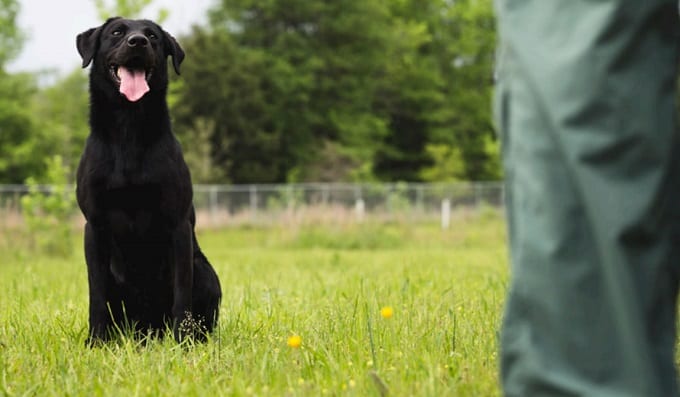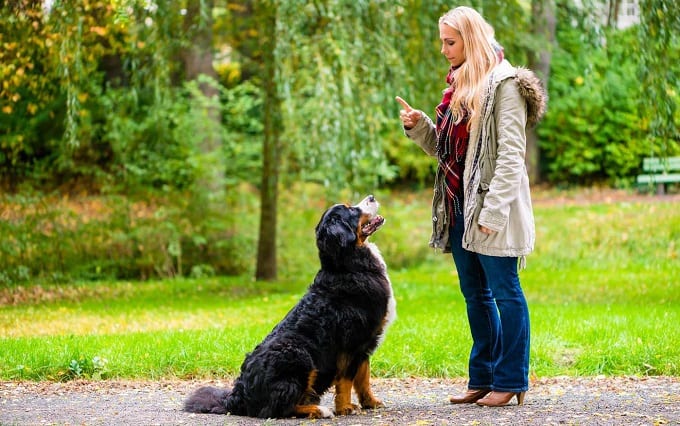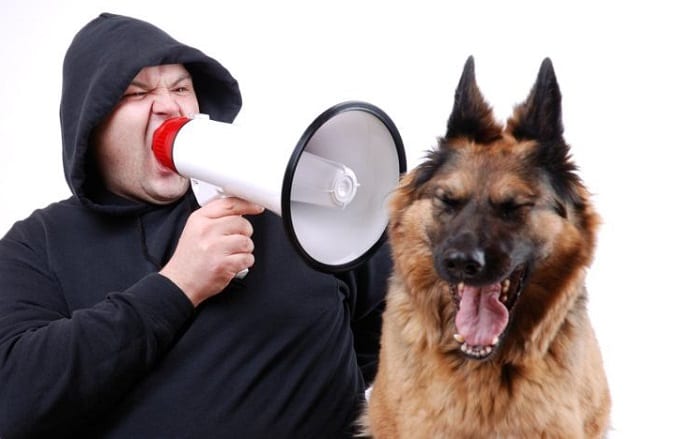There’s no question that training your dog can be challenging.
Even for professional trainers, some pups are just more challenging than others.
If you are a new dog owner, or even if you’ve had a couple of pups, you are probably aware that good training creates a polite and well-behaved dog.
However, lots of owners think that they are doing a great job of training their pooch, but can’t understand why their dog just isn’t getting the hang of the commands.
While your intentions may be in the right place, many dog owners make some pretty common mistakes when it comes to training their dog.
These common mistakes are so frequently made, that there are tons of books, websites, videos and blogs to help dog owners identify their errors, and offer suggestions on how to best correct and avoid these common mistakes.
We’ve done a bunch of research on these common errors in training, and have found easy ways that you can change your behaviors, to help your dog be successful.
Command Nagging

Command nagging is one of the most common training mistakes that dog owners make.
And, most dog owners don’t recognize that it is a behavior that is unproductive to training their pup.
Command nagging is at the top of our list of mistakes, because it is the one that is most frequently made by dog owners, is the simplest to fix, but it is also the most difficult “human” mistake to break.
What is command nagging, you might ask?
Command nagging is when you use a command over, and over, and over, expecting that your dog is going to perform if you use the command enough.
Command nagging isn’t a bad mistake, it’s just one that lots of dog owners make, and it doesn’t really accomplish anything productive.
How do you fix command nagging?
Just stop repeating yourself like a scratched record. It’s that simple. Request the command to your dog, once.
Then wait. Also, if your dog doesn’t respond, don’t give them a treat. You’ll be rewarding behavior that you don’t want to reward.
If your dog doesn’t respond to your initial command. Come back to the command after a few seconds, or remind your pup of the skill you are looking for.
Just don’t keep saying the command word over, and over.
Working Too Long
This is another really common mistake and it’s probably easier to fix than command nagging.
Here’s the scoop… dog owners love to think their pet is the smartest thing on the planet. And dogs are smart animals, but not as smart as we want to think they are.
Most dogs have the intelligence and attention span of a 3-year-old human. Yep, that’s right. Your dog is only as smart as your favorite toddler.
This perspective can be helpful when it comes to understanding why your dog loses interest when you’re training them.
Most dogs and toddlers can only focus on a task for an hour at the most. And, the younger your pup is, the shorter their attention span will be, so this time maybe even more condensed.
To fix this mistake, set a timer and limit your training time to a half-hour or so. When the timer goes off, stop.
Don’t keep going with the hopes that your dog will magically learn or pick up a skill. You and your dog will be happier and more successful, if you stop, and pick up again later.
Inconsistency

There is a big difference between inconsistency and command nagging, and they should not be confused.
Some dog owners think that a lack of consistency should be remedied by command nagging. Dogs need to hear the same word/phrase/command every time, in order to learn a skill.
If you use different words for the same skill, your dog will be confused, and won’t successfully learn the behavior you are looking for.
Inconsistency happens when you don’t use the same word, or response when requesting a command or skill from your dog.
This can happen when more than one member of the family is training the dog, but not working with the trainer. This is especially common when you introduce children to the training process.
Fixing this mistake is easy enough. Make sure that you use the same word or command for each skill, every time you work with your dog.
Then, make sure you share this with other members of the household so they can also use the same word.
This will ensure that training is consistent, and the level of confusion for your dog is reduced.
Not Enough Practice
This mistake is a huge step towards training failure.
You know that old saying, “practice makes perfect?” Well in the case of training your dog, this is the truth. Many dog owners get so frustrated with their dog because they don’t learn a skill.
However, when delving deeper into the problem, the dog is almost always, not the problem. The practice is almost always the problem.
With a limited attention span, your dog needs to see and repeat a skill many times for the skill to stick. The only way this happens is if you practice, practice, practice.
Failing to practice is the perfect recipe for failure. Help your pup be successful by taking the time to practice.
Our lives are busy, and your life probably is too. But that isn’t an excuse to skip practicing with your pup. Schedule a regular time to practice with your dog.
Make a calendar appointment with a reminder. Maybe it’s the first half hour after you come home from work.
Not only does this create a good routine, but it also helps your dog work off some of the built-up energy, from a day stuck at home.
Even after your dog has mastered the skills you wanted them to learn, it doesn’t hurt to continue this routine of practice, as a way to stimulate your dog’s brain, and create a positive connection between you and your pup.
One Size Doesn’t Fit All

Just like kids, each of your dogs is a unique individual, and each of your dogs will have a different mode of learning.
Sometimes this understanding doesn’t stick with us humans, and we try to force a technique on our dogs.
The problem with this is that trying to make a dog learn, in a manner that they don’t understand leads to failure of your dog, frustration for both of you, and more often than not, a dog that doesn’t learn and ends up being difficult to manage.
Just like with kids, you need to find the best ways to help your dog be successful.
This can be really simple, maybe all your dog needs is a different command word or instead of treats, a favorite toy as a reward.
As a person, you need to take the time to try to find the right way with your dog.
This may also mean that you may need to find a different trainer, or consult with a variety of training resources, to find the right solution for your pup.
Training While Frustrated
Nothing good ever comes from working on a task when you’re frustrated.
This is equally true when it comes to training your dog. We all have tough days, days when nothing seems to be going right, or just one of those days when staying in bed feels like the right answer.
If you’re having one of those days, or if you’re just feeling frustrated with the world, it’s a good idea to not train your pup.
Your dog isn’t going to intentionally frustrate you, but if you’re already frustrated, every little misstep of your pup is going to seem exponentially more challenging.
Your frustrating day doesn’t mean you should skip training your dog, but it does mean that you should take some time to relax, before jumping into your daily practice.
Likewise, sometimes your dog is having a day, and may not be responding well to training. This can be frustrating for you and for them. And it can lead to short tempers and bad behavior.
The easiest way to correct this mistake is to step away from training and regroup.
If your frustration comes from someplace other than your dog, use your pup as a way to relax and feel better. Instead of training, take your pup for a walk, play ball or just take some time to snuggle with your canine pal.
When you’re feeling better, take the time to practice. That may mean you miss a day of practice, but missing a day is much better than making practice a bad experience for your dog.
Yelling or Using a Harsh Voice

This mistake often goes hand in hand with the last training mistake we discussed. Nothing good ever comes from raising your voice or using an icky, harsh tone with your dog.
Yelling at your dog or using a harsh voice when training your dog, makes them feel like they are being bad.
Using a harsh voice or yelling makes training, which should be fun for you and your dog, a scary process for your dog.
You don’t want your dog to be afraid of you, and getting your dog to do things because they are scared, is not a successful outcome of training.
Bullying your dog into a result is mean, and leaves you with a dog that is timid and fearful.
Fearful dogs can become aggressive and display behaviors like biting or defensive growling that is undesirable.
Your best training results come with patience and a quiet voice.
If you are at a point in training with your dog, where you are frustrated, angry or don’t feel like you can continue without yelling, step away.
Take some time to calm down, and then reassess your process. You may need to switch techniques or find a different reward.
Whatever it takes, don’t yell at your dog, because everyone loses when you do.
Training in the Same Place
We’ve all met this dog owner… the one that swears their dog is a perfect angel at home but is a total jerk in public.
You’ve probably experienced this with the same person. Their dog is great at home, but step out the door, and all of a sudden, all of their training just vanishes. Maybe, you’re that person?
If you’ve only trained your dog in the comfort of your home, it’s no surprise that they can’t remember what they’ve learned when they go someplace new.
New smells, sounds, people, places, and other dogs can really confuse your dog. This confusion can lead to a failure to remember their skills.
When you’re training your dog, take them to different places and practice. This will help them learn to focus in new environments.
Poisoning Cues

This is a big mistake to make, and it can turn successful training into a complete failure in no time at all.
When you poison a cue, you use a command to get your dog to do something they don’t like.
For instance, if you use the word “go” to mean a car ride, which your dog loves, but then only take them to the vet, which they don’t love, your dog will associate that word with something unpleasant.
This will cause your dog to avoid, at all cost, this word and its result.
Make sure that you use cues in a variety of situations, not just the unpleasant ones so that your dog understands that each cue can have good and fewer fun results.
They’ll still respond to the cue, no matter the outcome because it isn’t just associated with something they don’t like to do.
Too Many Treats
When you’re training your dog, treats are meant to be a reward for doing something correctly.
A lot of dog owners forget this during training and give their dog a treat even when there isn’t behavior to reward.
The problem with this is that eventually, the treats lose their value. This means that your dog isn’t going to respond with the promise of treats, and training starts to go downhill.
If your dog is already here, you’re going to need to find a higher value reward, and then use it sparingly.
Otherwise, learn from the mistakes of others, and give treat rewards only when they are earned. Then your dog will continue to associate treats, with good behavior.
Conclusion
Training your dog can be a very rewarding experience.
Not only do you help your dog learn how to be well-behaved and polite, but training your dog gives you the opportunity to bond with your pup.
However, common mistakes can make training your pup a challenging and frustrating.
These common mistakes, that we’ve shared with you are easily resolved, and if you can avoid them, it will make training your pup a great experience for you both.
Do you have suggestions about other mistakes or ways to make training your pup easier?
Let us know your thoughts in the comments.
